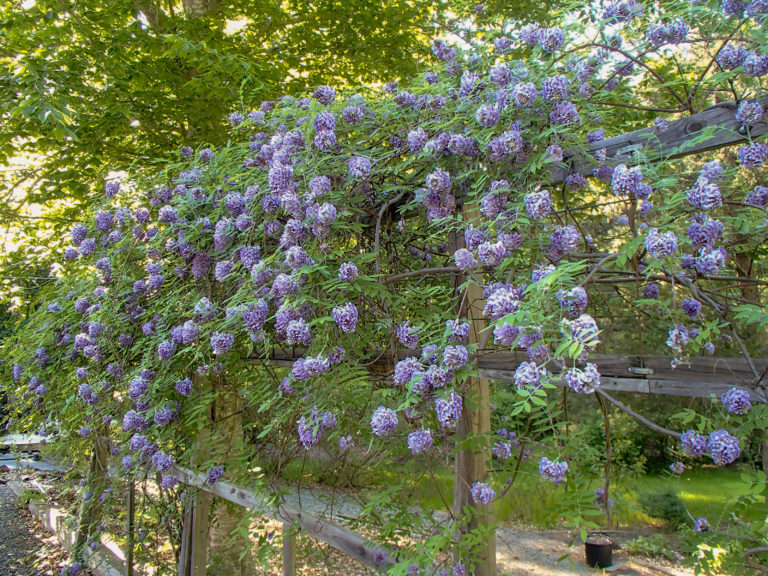Wisteria frutescens is a deciduous, woodland flowering vine 25 – 30′ in length, native to the coastal plain along our southeastern states, around along the Gulf coast over to Louisiana and up the Mississippi Rivery valley to Arkansas and Kentucky. It grows in damp habitats. The forest-threatening, thuggish Asian wisterias (both Chinese and Japanese) are familiar to most southerners, but the American Wisteria is gaining in popularity because while a satisfyingly vigorous grower in full sun, this vine is guaranteed not to be invasive. The lightly fragrant, pea-like flowers bloom in fat clusters in April and May, a heavenly bright lavender against handsome foliage. It also reblooms intermittently throughout the summer. Flowers are produced on new wood, and the plant thrives when heavily pruned. It can even be grown in a large container. On top of its eye-popping beauty, American Wisteria attracts hummingbirds, butterflies, and bees, and it is reported to be highly resistant to deer! Seedlings of the species require 5 to 10 years for first flowering. The ‘Amethyst Falls’ cultivar flowers reliably and early.
NURSERY HOURS
Wednesday: 10-4 Thursday: 10-6 Friday-Saturday: 10-4 Sunday: 12-4
Wisteria frutescens ‘Amethyst Falls’

Key Info
Scientific Name: Wisteria frutescens (L.) Poir. cv. 'Amethyst Falls'
Common Names: American Wisteria, Texas Wisteria, Kentucky Wisteria
Family Names: Fabaceae
Plant Type: Vine
Leaf Retention: Deciduous
Flower Color: Lilac
Additional Info
Habit: High growing woody perennial vine with counter-clockwise twining habit.
Height: 20'-30'
Spread: 20'-30'
Soil Conditions: Moist to mesic, acidic to circumneutral pH, sandy, sandy loam, medium loam, clay loam, clay.
Leaves: Alternate, compound leaves, with odd-pinnate arrangement of leaflets on the rachis, each leaf typically with 9-15 lance-shaped leaflets.
Flowers (or reproductive structures: Mildly fragrant, pea-like, lilac-purple flowers in cone-shaped racemes developing along with the leaves in April/May. The blooms only appear on new wood. Individual flowers are nearly 1 inch long and are lilac or bluish purple.
Fruit: Flowers give way to narrow, flattened, smooth, bean-like seed pods 4 or 5 inches long. These ripen over the summer from fuzzy greenish-tan to shiny brown and smooth when dry in the fall. They may split open in fall or may persists until winter.
Natural Distribution: Damp woods, stream banks,
USDA Hardiness Zone: 5 to 9
USDA Wetland Indicator Status in NC: FACW
Pollination: Butterflies
Wildlife Connections: This plant is a larval host of the Marine Blue butterfly, Zarucco Duskywing, Silver-spotted skipper and the Long-tailed skipper butterflies. It is deer resistant.
Propagation: Amethyst Falls is propagated by softwood cuttings in spring. The species can be propagated by seed as well.
